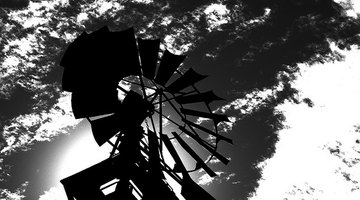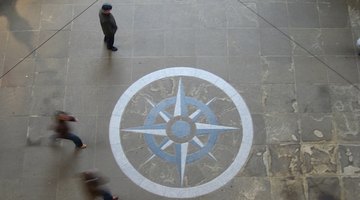Parts of the Wind Vane
In ancient times, it was believed that wind had magical powers. The first wind vane was built by Andronicus, a Macedonian astronomer, to honor the Greek god Triton. The initial design of the wind vane resembled a head and torso of a man with a fish tail.
A wind vane is a mechanical device used to measure the direction of the wind and was implemented to provide weather warnings for armies, ships and farmers. Several parts of the wind vane work together to determine wind direction. The terms "wind vane" and "weather vane" are often used interchangeably.

Purpose

Wind vanes can only measure wind directions a few meters off the ground. The instrument consists of an arrangement of a direction pointer, the two ends of which are known as the "tail" and "nose," pointing toward the direction from where the wind is going and the direction it is coming from, respectively. This is made possible due to the inherent design whereby the smaller area turns into the wind and vice versa.
Features
Wind vanes come in various designs and sizes, but they can be identified by their essentials parts--ornament, rod, cupola or dome-like structure, directional and finial.
The Ornament
The feature that makes different wind vanes unique is the decorative ornament that enhances its beauty. In ancient times, the ornamental piece was perceived as a status symbol and defined its owner. The design of the ornaments needs to be precise so that the mass on either side of the center is equal to maintain balance; at the same time, the area should not be same but should be unequal for the device to work. The ornament comes in different styles like arrows, full bodied and silhouettes, among others.
Rod
The rod, usually made of steel, is one of the critical parts of a wind vane as all the other pieces are connected to it. The height of the rod depends on the point where the vane is to be fixed and the surrounding area. The rod assists the ornament to rotate in the wind.
Globe, Directional and Finial
The globe is composed of two spheres--a large one and a small one--and are placed on the rod. The primary function of the directional piece is to indicate the directions--North, South, East and West.
At one time, finials are carved from precious stones and highlighted the top of a wind vane. It is believed that finials are better for lightning to strike at rather than at the house itself. In the past, it was believed that the finial could ward off evils, stop their progression and keep the place safe.
Cupola
The cupola is the ornate structure at the crown of a rooftop. Usually, wind vanes are placed on top of the existing cupola so as to serve as a foundation, of sorts. It is important that the size of the cupola and the wind vane be equal.
References
Writer Bio
Andrea Helaine has a Bachelor of Philosophy in theology and is currently finishing her thesis course for a Master of Fine Arts in creative writing. Helaine has been writing professionally for over 10 years and has been published in several anthologies and is currently breaking into the screenwriting market.
More Articles



